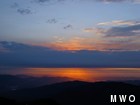Oh, the sights to see!
2010-05-29 21:52:59.000 – Ryan Knapp, Staff Meteorologist
Sunrise Saturday morning.
The weather this week looks to be a nice mix of everything the summit has to offer. The conditions for our first half of the week have consisted of relatively low winds, seasonable temperatures, with only brief fog and dynamic skies above. The weather for the second half of the week is shaping up to have higher winds, more fog, and possibly some thunderstorms mixed in with rain. It is a week like this that kind of provides us with a great smorgasbord of variety to report and in my case, photograph.
One of the most impressive things we got to see this week was the moons light reflecting off the Atlantic Ocean. In my time here, I have only seen the moon do this a handful of times due to several limiting factors. The biggest limiting factor is fog which envelopes the summit about 60 percent of the year. The second largest limiting factor is haze which can reduce visibilities to just miles at times, especially during the summer when a milky view is all too common. Other limiting factors might be low clouds, fog or a low marine layer on/along the coast, clouds aloft blocking the moons light, or the location of where the moon rises on the horizon since this changes with every moonrise over the seasons. But when everything lines up just right, we get a really neat scene.
Seeing the Atlantic with moon light is rare but just seeing the Atlantic in general is a bit difficult up here. The Atlantic Ocean from the summit is visible 65 miles to our southeast under optimal conditions. But most of the limiting factors for the moon light apply for sunlight too. In fact, sunlight makes things worst especially in the summer. As the sun rises, its light is scattered through any particulate matter (pollution, dust, sea salt, etc) in the atmosphere muddling the view of the coast. During the summer, only the clearest of clear days allows us to see the ocean during the daytime. The best time to see the ocean is during the winter during sunrise when the sun rises in the southeast and its light reflects off the surface creating an orange or silver strip on the southeast horizon.
But the moons light on the ocean isn’t the only optical effect that has been occurring this week. The sky has been presenting some other interesting sights during sunrise/sunset my past two shifts. It started my last shift with the weird ribbon like clouds that formed around the summit during sunrise. This week, I have seen a blood red moon (sorry it’s a bit fuzzy but I was using a digital zoom), reddish streaks during sunrise and sunset as well as very vibrant colors during the sunrise and sunset hours. I haven’t nailed down what is causing these optical effects but in my time here and growing up out west, there are two things at the top of my list. The first is smoke. When I was growing up out west, smoke from forest fires (sometimes closer than I would want them to be) would produce similar red moons and vibrant sunrises and sunsets. Now, the northeast isn’t prone to burn as often but three summers ago, there were large forest/grass fires in the Midwest US/Canada that were sending smoke our way. It wasn’t thick smoke but just enough to affect the skies above. But I tried to scour the web for possible sources of smoke and fell short of finding anything substantial. The other source is volcanic ash. Last summer, several eruptions in Alaska provided vibrant colors on the east coast during sunrise and sunset. This year, the only eruption I am aware of is the Icelandic one but most experts have stated that the ash from these should have dissipated by the time it reached here. But from personal experience, even “experts” can be caught off guard. Since I don’t have any concrete evidence for the source as of this writing, the mystery of the weird clouds and color will have to remain unsolved. But I will let you know if I find out anything in the future.
Two theories I found overnight for the recent red skies: Spring burning of fields in the Midwest as seen in this NASA satellite view. But the more realistic reason is from 56 forest fires burning in Quebec as seen here in this CBC article. This makes the most sense since it has smelled like smoke the past few days up here especially with a northern wind.
Ryan Knapp, Staff Meteorologist
Team Flags Return for Seek the Peak’s 25th Anniversary
Team Flags Return for Seek the Peak's 25th Anniversary By MWOBS Staff Mount Washington Observatory is looking forward to continuing a much-loved tradition for Seek the Peak’s 25th Anniversary: Team flags. In inviting teams
Meet Summer Interns Zakiya, Max and Maddie
Meet Summer Interns Zakiya, Max and Maddie By MWOBS Staff We are excited to welcome six teammates to the summit of Mount Washington this summer! During their internship, these students and graduates will play
Saying Goodbye to the Summit
Saying Goodbye to the Summit By Alexis George After an extraordinary last three years working as a Weather Observer and Meteorologist, I am excited to pursue a different career. As sad I as am






